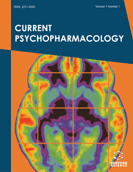Abstract
Background: Tianeptine is an atypical antidepressant marketed as Stablon since the late 1980's. While chemically very similar to tricyclic antidepressants, tianeptine was thought to have the apparently paradoxical mechanism of action of enhancing serotonin reuptake. However, recent data highlight a multimodal pharmacology for tianeptine including actions at glutamatergic synapses (inhibiting NMDA receptors and an indirect effect on AMPA receptors) coupled with agonist effects at mu opioid receptors (µ-receptors).
Objective: We have reviewed clinical and preclinical data for tianeptine to provide a comprehensive study of its pharmacology.
Results: Clinical trials show that tianeptine is at least as efficacious as first-line antidepressant treatments, with improved tolerability as it is significantly less prone to disrupting the patient's normal functionality. Tianeptine appears more efficacious in males than females, although these gender-specific differences may be accounted for by pharmacokinetics. Preclinical data suggest that the ability to stabilise glutamatergic neurotransmission may underlie tianeptine's ability to improve cognitive function and anxiety-related symptoms. Alternatively, µ-receptor activation of the mTOR signalling pathway could lead tianeptine to be a fastacting antidepressant. Agonist actions at µ-receptors could also explain the potential abuse liability and dependence issues seen with high dose tianeptine.
Conclusion: Tianeptine itself is off patent, but it still holds much promise as an experimental tool yielding valuable insights into the molecular mechanisms underlying depression.
Keywords: Depression, anxiety, serotonin, glutamate, µ-opioid receptor, gender, mTOR.
Graphical Abstract
Current Psychopharmacology
Title:Tianeptine: An Atypical Antidepressant with Multimodal Pharmacology
Volume: 6
Author(s): Sarah J. Bailey*, Abdulrahman Almatroudi and Andreas Kouris
Affiliation:
- Department of Pharmacy and Pharmacology, University of Bath, Claverton Down, Bath BA2 7AY,United Kingdom
Keywords: Depression, anxiety, serotonin, glutamate, µ-opioid receptor, gender, mTOR.
Abstract: Background: Tianeptine is an atypical antidepressant marketed as Stablon since the late 1980's. While chemically very similar to tricyclic antidepressants, tianeptine was thought to have the apparently paradoxical mechanism of action of enhancing serotonin reuptake. However, recent data highlight a multimodal pharmacology for tianeptine including actions at glutamatergic synapses (inhibiting NMDA receptors and an indirect effect on AMPA receptors) coupled with agonist effects at mu opioid receptors (µ-receptors).
Objective: We have reviewed clinical and preclinical data for tianeptine to provide a comprehensive study of its pharmacology.
Results: Clinical trials show that tianeptine is at least as efficacious as first-line antidepressant treatments, with improved tolerability as it is significantly less prone to disrupting the patient's normal functionality. Tianeptine appears more efficacious in males than females, although these gender-specific differences may be accounted for by pharmacokinetics. Preclinical data suggest that the ability to stabilise glutamatergic neurotransmission may underlie tianeptine's ability to improve cognitive function and anxiety-related symptoms. Alternatively, µ-receptor activation of the mTOR signalling pathway could lead tianeptine to be a fastacting antidepressant. Agonist actions at µ-receptors could also explain the potential abuse liability and dependence issues seen with high dose tianeptine.
Conclusion: Tianeptine itself is off patent, but it still holds much promise as an experimental tool yielding valuable insights into the molecular mechanisms underlying depression.
Export Options
About this article
Cite this article as:
Bailey J. Sarah *, Almatroudi Abdulrahman and Kouris Andreas, Tianeptine: An Atypical Antidepressant with Multimodal Pharmacology, Current Psychopharmacology 2017; 6 (2) . https://dx.doi.org/10.2174/2211556006666170525154616
| DOI https://dx.doi.org/10.2174/2211556006666170525154616 |
Print ISSN 2211-5560 |
| Publisher Name Bentham Science Publisher |
Online ISSN 2211-5579 |
 42
42 6
6 1
1
- Author Guidelines
- Bentham Author Support Services (BASS)
- Graphical Abstracts
- Fabricating and Stating False Information
- Research Misconduct
- Post Publication Discussions and Corrections
- Publishing Ethics and Rectitude
- Increase Visibility of Your Article
- Archiving Policies
- Peer Review Workflow
- Order Your Article Before Print
- Promote Your Article
- Manuscript Transfer Facility
- Editorial Policies
- Allegations from Whistleblowers
- Announcements
Related Articles
-
Mechanistic Approach to Understanding Psychosis Risk in Velocardiofacial Syndrome
Current Pediatric Reviews HTLV-1-Associated Myelopathy/Tropical Spastic Paraparesis (HAM/TSP): Still an Obscure Disease
Central Nervous System Agents in Medicinal Chemistry Discovery of Small Molecules that Target Autophagy for Cancer Treatment
Current Medicinal Chemistry Natalizumab Modifies Catecholamines Levels Present in Patients with Relapsing- Remitting Multiple Sclerosis
Current Pharmaceutical Design Validation of Two High-Performance Liquid Chromatographic Methods for the Analysis of Nadolol and Propranolol Hydrochloride Following In Vitro Transdermal Diffusion Studies
Current Pharmaceutical Analysis Editorial (Thematic Issue: W(e)nt to the Brain: Wnt Signaling in Neurological Disorders)
CNS & Neurological Disorders - Drug Targets Folic Acid Can Contribute to Memory Deficit and Na+, K+- ATPase Failure in the Hippocampus of Adolescent Rats Submitted to Hypoxia- Ischemia
CNS & Neurological Disorders - Drug Targets Editorial [Hot Topic: Neurotransmitter Transporters Guest Editor: Dr. Anders A. Jensen ]
Current Topics in Medicinal Chemistry The Insulin-like Growth Factor-1 Axis and its Potential as a Therapeutic Target in Central Nervous System (CNS) Disorders
Central Nervous System Agents in Medicinal Chemistry The Dopamine D<sub>2</sub> and Adenosine A<sub>2A</sub> Receptors: Past, Present and Future Trends for the Treatment of Parkinson's Disease
Current Medicinal Chemistry Borderline Personality Disorder in Young People and the Prospects for Prevention and Early Intervention
Current Psychiatry Reviews Maternal Sepsis 2010: Early Recognition and Aggressive Treatment with Early Goal Directed Therapy can Improve Maternal Outcomes
Current Women`s Health Reviews Editorial [Hot Topic: Stem Cells and Tissue Regeneration (Executive Guest Editor: Roberta Di Pietro)]
Current Pharmaceutical Design Nerve Growth Factor and Brain-Derived Neurotrophic Factor in Schizophrenia and Depression: Findings in Humans, and Animal Models
Current Neuropharmacology Synthesis of Novel 8-alkylamino-5, 6-dihydro-4H-benzo[f] [1,2,4]triazolo [4,3-a]azepines as Anticonvulsant Agents
CNS & Neurological Disorders - Drug Targets Butyrylcholinesterase: A Multifaceted Pharmacological Target and Tool
Current Protein & Peptide Science The role of interleukin 35 in atherosclerosis
Current Pharmaceutical Design Are Raw Scores on Memory Tests Better than Age- and Education- Adjusted Scores for Predicting Progression from Amnesic Mild Cognitive Impairment to Alzheimer Disease ?
Current Alzheimer Research Reduced Risk of Incident AD with Elective Statin Use in a Clinical Trial Cohort
Current Alzheimer Research Sex Differences in Biomarkers for Predicting Cardiovascular and Coronary Events
Current Vascular Pharmacology


























